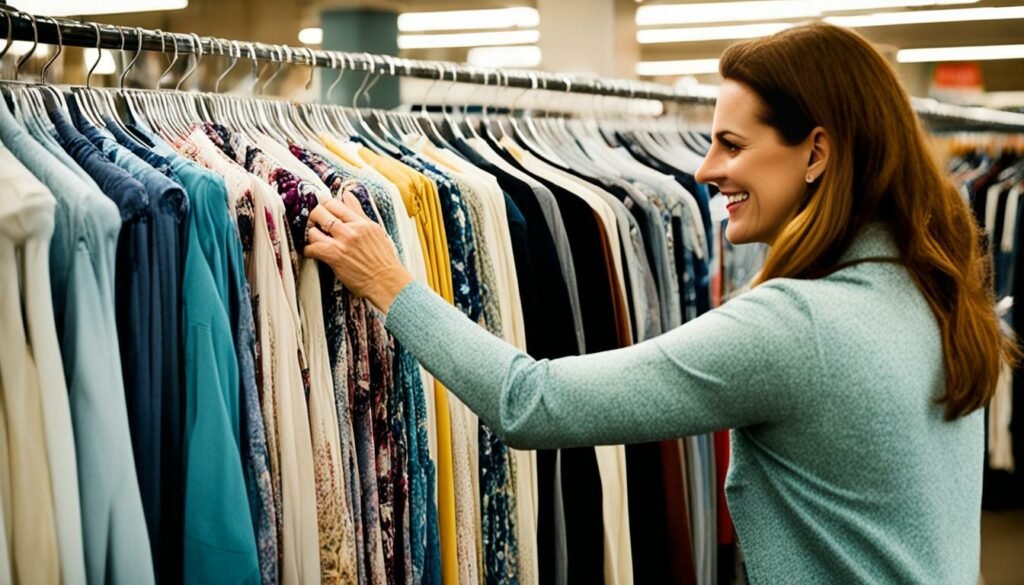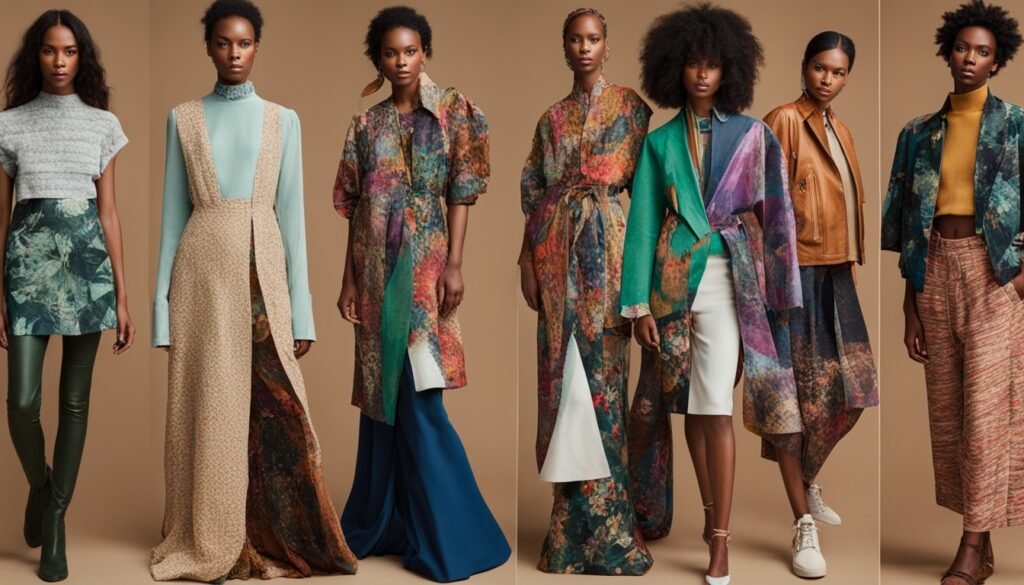Did you know that annually, the fashion industry generates about 92 million tons of textile waste? This staggering figure underscores the pressing need for sustainable practices within the fashion sector. I’ve taken steps towards zero waste fashion, eager to share tips that blend eco-consciousness with style.
This guide delves into sustainable clothing and the slow fashion movement. It demonstrates how we can aid in creating a greener planet. By supporting brands that prioritize the environment, we can significantly impact sustainability. These tips are designed to aid anyone looking to update their wardrobe or adopt a more sustainable lifestyle.
For a deeper exploration of embracing zero waste fashion, check out this resource. Let’s start this eco-chic journey together!
Understanding Zero Waste Fashion
Zero waste fashion is a design approach focused on eliminating textile waste during production. It promotes sustainable fashion by utilizing materials efficiently, ensuring nothing is discarded. The Ellen MacArthur Foundation highlights that 87% of clothing fibers end up as waste, underscoring the need for change in our consumption habits.
What is Zero Waste Fashion?
This philosophy employs upcycling and innovative designs to utilize every piece of fabric. By reducing consumption and using sustainable resources, we can decrease the environmental impact of clothing production. Exploring zero waste fashion, I’m inspired to rethink my clothing choices.
The Importance of Sustainable Fashion
Sustainable fashion is crucial for both environmental and social reasons. Fast fashion has led to a culture of disposability, exacerbating textile waste and pollution. By adopting sustainable practices, I support a consumption model focused on quality over quantity. Understanding eco-friendly fashion empowers me to make choices that benefit the planet and reflect my values.
Embracing the Slow Fashion Movement
I’ve been drawn to the slow fashion movement, which values thoughtful production and consumption. It highlights the craftsmanship and environmental impact of our choices. This shift has changed how I shop, focusing on ethical fashion brands that align with my values and support sustainability.
What is Slow Fashion?
Slow fashion transcends mere style, advocating for a departure from fast production and disposable trends. It champions quality over quantity, encouraging us to value the craftsmanship in each piece. This mindset motivates me to invest in garments made with care, using sustainable materials that protect our planet.
Benefits of Slow Fashion for the Planet
The impact of slow fashion is significant and extensive. It promotes durability, reducing textile waste and carbon emissions. By choosing slow fashion, I help conserve natural resources and support local economies. Patagonia and Eileen Fisher are leaders in sustainable fashion, using eco-friendly materials and ethical labor practices.
| Benefit | Description |
|---|---|
| Reduced Waste | Slow fashion focuses on durability, which minimizes textile waste. |
| Lower Carbon Footprint | Mindful production processes lead to decreased carbon emissions. |
| Ethical Production | Supports workers’ rights and fair labor practices in the fashion industry. |
| Resource Conservation | Promotes careful use of natural resources, ensuring they are available for future generations. |
Embracing the slow fashion movement gives my clothing choices a new purpose and connects me to the stories behind the brands I support.
Zero Waste Fashion Shopping Tips
Adopting zero waste practices has reshaped my wardrobe and my environmental footprint. I’ve discovered several strategies for making sustainable fashion choices.
Shop Secondhand for Eco-Friendly Choices
Choosing secondhand clothing is a prime way to embrace zero waste. It reduces landfill waste and lessens the demand for new, resource-intensive items. Goodwill and local thrift stores are full of unique pieces. Online platforms like Poshmark offer even more variety, all while promoting sustainability.
Invest in Quality over Quantity
I focus on quality over quantity in my purchases. High-quality items endure longer, reducing the need for constant replacements. I seek out brands that prioritize ethical manufacturing. Details like robust seams and long-lasting fabrics guide my choices.
Look for Upcycled and Sustainable Brands
Now, many brands are dedicated to upcycled fashion and sustainability. United By Blue and Kowtow are leaders, using eco-friendly materials and ethical processes. By supporting these brands, I help foster a fashion industry that values the environment and fair labor.

The Importance of Ethical Fashion Brands
Understanding the role of ethical fashion brands is crucial for making informed fashion choices. These brands not only match my style but also uphold values of sustainability and fairness.
Characteristics of Ethical Brands
Ethical fashion brands stand out due to their distinct features. They focus on transparent supply chains, allowing me to see where my clothes come from. Fair labor practices ensure workers are treated fairly and paid right. Sustainable materials are key, aiming to reduce environmental impact.
These brands use eco-friendly methods, from organic fabrics to recycled materials, to cut down on waste.
Examples of Eco-Friendly Brands to Support
Choosing eco-friendly brands is a step towards sustainable fashion. Brands like Eileen Fisher, Patagonia, and Synergy stand out. They use organic and upcycled materials, showing a dedication to style and sustainability.
Shopping from these ethical fashion brands aligns my purchases with my values. It helps shape a more responsible fashion industry.

| Brand | Characteristics | Materials Used |
|---|---|---|
| Eileen Fisher | Fair labor practices, eco-friendly production | Organic cotton, Tencel |
| Patagonia | Transparency, sustainable sourcing | Recycled polyester, organic hemp |
| Synergy | Upcycled materials, ethical manufacturing | Organic cotton, recycled fabrics |
Shopping Local and Supporting Your Community
Shopping locally has a significant impact on both the environment and my community. It reduces carbon emissions from transportation and strengthens community bonds. Moreover, it supports local artisans and craftspeople, offering unique items that reflect regional culture and craftsmanship.
Benefits of Buying Locally
Local shopping benefits go beyond just supporting small businesses. It helps maintain economic stability and creates jobs in the community. These businesses often prioritize ethical production, ensuring their products are made with care. This approach embeds sustainability into my wardrobe choices.
Moreover, discovering unique treasures from my neighbors is a rewarding experience. It allows me to appreciate the artistry of those around me.
Resources for Local Shopping
Locating local shopping resources is straightforward; community boards, social media groups, and local directories often list nearby stores. Farmer’s markets and craft fairs provide opportunities to meet vendors committed to sustainability. Platforms like Etsy connect me with local artisans specializing in handmade or small-batch clothing production.
This empowers me to make environmentally conscious choices. For more insights on living sustainably while shopping locally, I found helpful tips on zero-waste lifestyle tips.
FAQ
What are some practical zero waste fashion shopping tips?
Effective tips include shopping secondhand and investing in high-quality clothing. Look for upcycled and sustainable brands, and support local artisans. These practices reduce waste and promote a sustainable wardrobe.
How does zero waste fashion work?
Zero waste fashion aims to minimize textile waste by efficiently using resources during production. It focuses on sustainable materials, upcycling, and reducing consumption. This approach creates a circular fashion model.
What does the slow fashion movement entail?
The slow fashion movement advocates for mindful consumption and slower production. It encourages valuing quality over quantity. This means focusing on well-made clothing that minimizes environmental impact.
Why should I consider shopping secondhand?
Shopping secondhand diverts clothing from landfills and reduces demand for new production. It offers unique fashion finds and supports a zero waste lifestyle. This makes it an eco-friendly choice.
What are some examples of ethical fashion brands?
Examples of ethical fashion brands include Patagonia, Eileen Fisher, Blue Canoe, and Alternative Apparel. These brands prioritize fair labor, transparent supply chains, and sustainable materials in their production.
How does buying locally support sustainability?
Buying locally reduces carbon emissions from transportation and supports the local economy. It often leads to unique, handcrafted items that reflect regional culture. This promotes sustainability in your community.
What should I look for when selecting sustainable clothing?
When choosing sustainable clothing, look for eco-friendly materials, ethical manufacturing, and durable construction. Brands using organic, upcycled, or recycled fabrics often meet sustainable and ethical standards.
How can I build a capsule wardrobe while embracing sustainable practices?
Building a capsule wardrobe means curating a limited collection of versatile, high-quality pieces. Focus on sustainable items you love. This promotes a responsible fashion lifestyle.
What are some resources for finding local, sustainable shops?
Resources for finding local sustainable shops include community boards, local directories, and social media groups. Farmer’s markets and craft fairs often feature sustainable vendors. Websites like Etsy can help locate local artisans.


